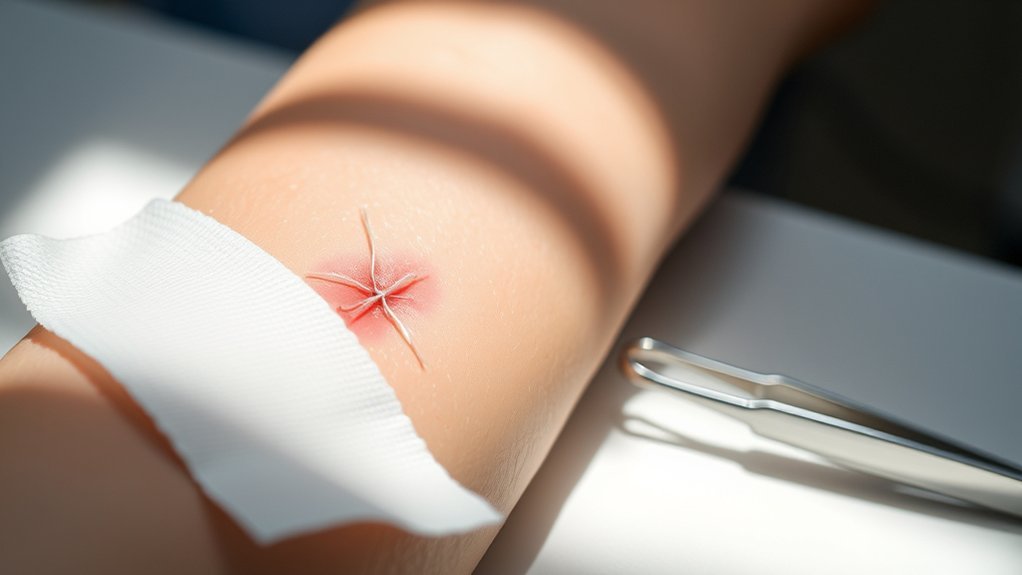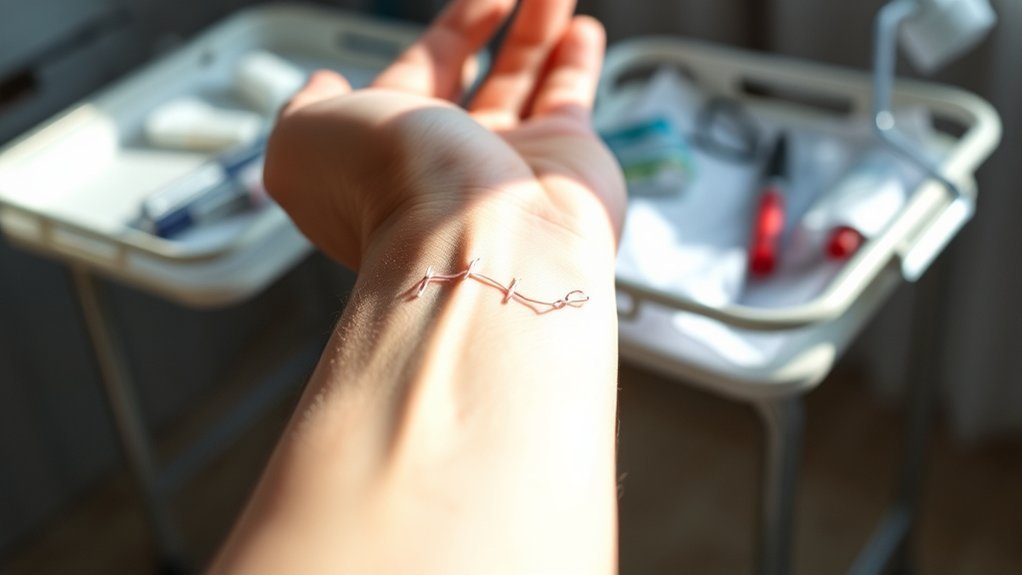Imagine you’ve just had stitches after a minor surgery, and everything seems fine until you notice some redness and swelling around the area. It’s important to understand how to care for your stitches and when to seek medical help. Knowing the signs of infection and other complications can make a significant difference in your recovery. Let’s explore the key indicators that warrant a call to your doctor.
Understanding Stitches and Their Purpose
Stitches, or sutures, play an essential role in wound care by closing cuts and promoting healing. They bring the edges of your skin together, which helps reduce pain and minimizes scarring.
For deep cuts, two layers of stitches may be used: the upper layer is visible and needs to be removed, while the deeper layer dissolves over time. Typically, you’ll have your stitches removed within 7 to 14 days to guarantee proper healing.
It’s vital to keep the area clean and dry, as this helps prevent infection. Monitor your cut carefully and avoid activities that could reopen it. If you notice excessive pain or unusual symptoms, don’t hesitate to call your doctor for further care.
Signs of Infection to Watch For
After getting stitches, it’s important to keep an eye on your wound for signs of infection. Watch for increasing pain, swelling, warmth, or redness around the cut. Here are some key indicators to monitor:
| Signs of Infection | Symptoms to Watch For | Action Needed |
|---|---|---|
| Redness | Red streaks extending from the cut | Contact healthcare provider |
| Swelling | Presence of pus draining | Seek medical attention |
| Fever | Temperature over 100°F (37.7°C) | Get prompt care |
| Numbness/Tingling | Sensations beyond the wound area | Immediate evaluation needed |
If you notice any of these symptoms, don’t hesitate to contact a healthcare provider for assessment and possible intervention. Your health is a priority! Additionally, being aware of safe sleep practices can contribute to overall well-being during recovery.
When Pain Becomes a Concern
While managing your recovery, it’s essential to pay attention to any changes in pain levels following your stitches. If you notice new pain or existing pain worsens, seek medical care, as this could indicate complications.
Be vigilant for other symptoms: cold, pale, or changed skin around the stitched area may suggest reduced blood flow and needs prompt evaluation by a healthcare provider. Tingling, weakness, or numbness around the cut should also prompt you to consult a doctor.
Excessive bleeding that soaks through your bandage or difficulty moving the affected area signals a potential issue requiring immediate attention.
Finally, watch for signs of infection like increasing pain, swelling, redness, or fever, and contact your doctor if these symptoms arise.
Monitoring for Complications

As you recover, it’s vital to keep a close eye on your stitches for any signs of complications.
Monitor for excessive bleeding that soaks through the bandage; this may indicate a problem that needs medical attention.
Keep an eye out for excessive bleeding through the bandage, as this may signal a need for medical attention.
Look for signs of infection, like increased pain, swelling, warmth, redness, red streaks, pus, or fever—if you notice any of these, call your doctor.
Cold, pale, or color-changed skin near the cut could suggest compromised blood flow; seek immediate medical care in this case.
Report any new symptoms, such as worsening pain, tingling, weakness, or numbness near the cut, as these might indicate nerve issues.
It’s important to address any problems promptly to guarantee proper healing and avoid complications.
Follow-Up Care and Medical Advice
To guarantee your stitches heal properly, attending all follow-up appointments is essential. During these visits, your healthcare provider will monitor healing and assess if stitches removal is needed within 7 to 14 days.
Keep an eye out for signs of infection, like persistent pain, redness around the wound, swelling, or pus. If you notice any concerning symptoms, contact your healthcare provider immediately.
It’s also important to track any medications you’re taking; discuss over-the-counter pain relief options if you’re not on prescription medication. Staying informed and proactive can greatly impact your recovery, so don’t hesitate to reach out if you have questions or concerns about your healing process. Additionally, consider consulting with OB/GYN specialists for comprehensive care in your recovery.
Your health is a priority!
Frequently Asked Questions
When to See a Doctor After Stitches?
You should see a doctor if you notice increased pain, swelling, or redness around the stitches, any signs of infection, excessive bleeding that won’t stop, or changes in skin color near the cut.
How to Know if Stitches Are Ok?
Your stitches are okay if there’s mild redness and swelling, but no increasing pain or pus. If they’re intact and the cut edges align, you’re likely healing well. Watch for signs of infection or unusual symptoms.
How Do I Know if I Need to Go to the Hospital for Stitches?
If your cut’s deep, wide, or won’t stop bleeding after 10 minutes of pressure, head to the hospital. Also, seek help if you see debris, notice signs of infection, or feel numbness around the wound.
Do Stitches Heal Faster, Covered or Uncovered?
Stitches heal faster when they’re covered. A nonstick bandage protects your wound from contaminants and maintains moisture, promoting quicker healing. Just be sure to follow your healthcare provider’s advice on changing the bandage.
Conclusion
Taking care of your stitches is essential for a smooth recovery. Watch for signs of infection, listen to your body when pain escalates, and stay alert for any unusual changes. Trust your instincts—if something feels off, don’t hesitate to reach out to your doctor. By staying informed and proactive, you can guarantee healing is on track, comfort is restored, and peace of mind is achieved. Remember, your health is worth every effort.
